The original NexStar telescopes are great instruments. Ours has seen many uses, from dark skies to not so dark skies as it has been set up in the Arizona Desert, the summit of Mauna Kea, or various school yards and resorts for public viewing. It has been used as a visual instrument, a photographic ‘scope, even done a little real work.
For the most part the scope has worked well, and has been well maintained, even updated with the latest hand pad controller. But on occasion there is a problem… connection issues would crop up. The dreaded “No Response 16” or “No Response 17” errors would appear, indicating that the motor control board is not talking. This would result in having to power cycle and realign the telescope.
Lately the errors have become more problematic. The last straw was a public event I recently used the telescope for, setting up the telescope for Halloween. Continual errors plagued the evening, a constant struggle. While the scope usually tracked, I could not use GOTO as each alignment was quickly off by just enough to be useless.
I have had the telescope apart too often in attempts to fix this, inspecting and re-seating the cables. This usually works, the problem will go away, for a while.
In general I like what I see inside the telescope. A well designed piece of kit with good components. Decades of taking gear apart have provided me so many examples of poor or good design. Inside the NexStar I just like what I see. The telescope is easy to get apart, just a few screws to remove each cover, exposing everything you might need to work on. The designers of this telescope obviously took pride in their work, it shows.
The exception to this is the wiring. There are a number of issues that can create trouble. Or rather there were a few issues, I just took care of that…
Most of the cables throughout the telescope are made from flat modular cable, the type of cable designed for telecom use. This cable is cheap and easy to work with, often found in applications outside the telephone industry. Not the best choice, but not a total disaster. The 26AWG is a little light to be used for power, as it is here. This is somewhat worrisome when used for DC motor power between the PCB’s. The wire gauge is fine for communication signals. Another possible problem is that the wire strands are not plated, rather they are bare copper and subject to corrosion if in a crimped or IDC connection.
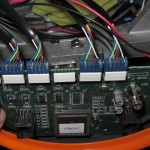
The cables are terminated with MTA 100 connectors, a form of insulation displacement connector (IDC) that uses a special tool to set the wire into the contact. I do have one of these tools, an expensive pistol style tool that I have not used in years. A couple times in my years of experience I have had trouble with MTA connectors, wires working loose and the resulting intermittent connections. If set properly these connectors work reasonably well, but it is all too easy to have a wire not set into the contact properly.
The blue connector body indicates these are to be used with 26AWG wire, just right for the flat modular cable used in most of these cables. Wrong for the 20AWG wires used for the power and elevation position switch wires in the telescope.
I generally avoid using these connectors in my own designs. This is particularly true in a situation where vibration is to be expected and where corrosion might be an issue. Places like a portable telescope perhaps? Add one more bad experience to the list, there is clearly an intermittent connection or two in this telescope.
Worse… Several of the cables inside the ‘scope were constructed with cable assemblies that were coupled together. To do this they simply took a PCB header and plugged two cables together. Let me repeat that… They plugged two cables together with a PCB header! The header is not meant to do this, it is designed to solder into a circuit board. The pins on one side are too short to properly seat into a cable connector and there is no locking mechanism to hold one of the two connectors.
When I disconnected one of these cables I found that one of the pins had slid up into one side, leaving the already too short side even shorter. I just found out why the hand-pad connector in the arm has been inoperative! Used in a PCB this would not happen, the pin would be held in place by virtue of being soldered into the board. Using the header as a coupler this was likely to happen, it is a smooth pin pressed through the soft plastic.
What to do? Replace each cable assembly with a reliable and robust cable that I can trust.
To this end I began replacing the cables one by one. Every single cable in the telescope.
Doing the cables one at at time allowed me to keep everything sorted and test each cable as it was installed. Pull the cable out, copy the cable using good components and wire, compare the new and old cables wire by wire, then install and test.
It took three evenings to replace the dozen odd cable assemblies. I built the assemblies from scratch using individual wires and braided nylon sleeving. I used 22AWG wire, notably heavier than the 26AWG wire found in flat modular cable. To replace the MTA connectors I used 0.1″ Molex KK series housings, crimping the pins and then running solder through the crimp and wire to insure permanent, trouble free connections. This results in durable and neat cable assemblies throughout the body of the telescope.
Examining the assembly I could see no reason why the troublesome cable couplers were present to begin with. Why did they not simply run a complete cable? This is what I did, run the previously coupled cables through without interruption.
With only a couple exceptions I used the same color codes as the original cables. This allowed a quick side by side comparison of each cable. Flipping a wire or two could so easily result in permanent damage to some difficult to replace component. It was important to pre-check each new part prior to applying power.
Also added were a few more tie-downs, nylon zip ties and mountings to secure the cables as they laced throughout the body of the telescope. In a portable device this restrains the cables, keeping them from flopping around.
I did engage in a little more substantial modification at each motor. as the motor leads were permanently attached I could not replace these cables as easily. The encoder presented a similar difficulty, it uses connector style that I did not have on-hand and could not so easily replace. My solution was to install a small terminal strip beside each motor. The motor and encoder is wired to the terminal strip. A new cable assembly runs from the terminal strip to the motor control PCB.
The original motor power cables were constructed with two conductor shielded cable, not a bad idea for a brushed DC motor that generates a substantial amount of electrical noise. A good idea, if you bothered to connect the shield to anything! They did not, the shield was left tied back and floating at each end. I did not bother to use a shield in the new cable, there was no place to tie it through the connectors, I simply routed the motor power leads separately from the encoder leads to avoid noise pickup.
I did include a filter ferrite in the motor leads, a couple turns through a toroidal ferrite core. This will not harm anything, and will reduce the electromagnetic noise coupled into the remainder of the circuitry.
With the new cabling in place I have yet to see a “No Response” error. The scope operates smoothly, with accurate GOTO performance. I never found a definitive solution to the errors when dissecting the old cables. Best guess is that the light 26AWG wire allowed motor currents and noise to disrupt the communication signals. The errors would only occur once the motors were powered up, slewing or tracking. Hopefully the improved cables and heavier wire will tame this issue.
This is an original NexStar telescope that is in essentially the same condition as the day we brought it home in early 2002. It is a great telescope, and I hope to keep it operational for many years. The upgraded wiring should remove the only issues we have been having with the scope. Now I just need to get it out under a dark sky and do more “testing”.
Update: I have also modified the GPS battery with a holder for easy battery replacement.

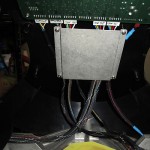
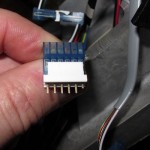
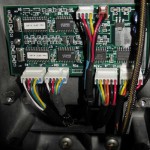
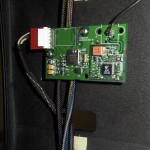
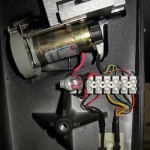


Thank you!! I’ve have struggled with my NX11 for 8 year with No Response 16/17. Replaced the power supply etc, but always came back to lifting the hood, wiggling wires, and concluding that something was not right in the wiring. Unlike you, I’m not expert in such matters, but have noticed the feel of the connectors wasn’t right. I do public astronomy exclusively — so these errors are a HUGE downer — and have resorted to simply taking my old C-8 out. Thanks again for the post — I’ll report back manage to pull off the re-wiring.
Tad
Hi there,
I’d like to know what you think the issue may be with my scope: while I can power up the scope and surf within the hand controller menus, everytime a command is sent requiring the motors to move, the displays say “no response 16 (or 17)”. Interestingly, I cannot connect the scope to my computer anymore; the device manager does not assign a com port, so I cannot use any software to talk to the scope.
Sounds like a cabling issue, or perhaps a failure on the interconnect PCB under the base panel. If the handpad powers up you have power to the scope and the pad, this will let you navigate all of the menus as you have noted, you just can not move anything, get a GPS fix or see the encoders move. The 16/17 error means there is no communications with the motor control board. I will suggest a few things…
Try different ports, there are up to three places the handpad can plug in. On my original GPS scope you can use either AUX port or the hadpad connection point in the arm.
Try a different handpad, it may be the handpad cable as this gets flexed a lot in normal use and will eventually fail. Do have one around or one you can borrow? If you know how to use a meter you can check to connections in the cable by ohming the wires from end to end, this requires opening the handpad to get the one end of the cable.
Open the base section of the telescope and check the connections, there may be a connector loose inside the telescope.
Hope this helps!
Hello Andrew, The rewiring a telescope article is just what I am looking for. Is there a schematic available of your modification? It would be helpful if there is. Thank you, Joe
Sorry, did not create one as I worked. No real reason to… I removed one cable at a time and duplicated it. You can check it wire for wire before installation to be sure you get it right before re-installing it. Then test that cable and move on. If you do it carefully and bit-by-bit there should be little chance to mess it up.
My other hint… Take lots of photos as you disassemble the scope, cell phone pics work well in case you have any questions later. I do this at work too, when working on a slightly larger telescope.
Thanks for the post.
I seems like Celestron is using cheap components to cut cost, while not lowering there prices.
I received a 130 SLT scope for Christmas and had this issue out of the box. Needless to say, it is going back to the manufacturer for a full refund!
Hi, I bought an Celestron 130 SLT. It also has this issue (16,17), and upon my net search for the possible cause I stumbled on this article. Well done Andrew, I suspect with the other folks also, it does point to this being the problem. I’ll investigate further! Thanks for the detailed write up!
Hi, My GPS has started doing something similar with 16 & 17 errors. I reseated cables and eventually operation returned. I am thinking about replacing the cables as you have done, but I have a question: when you switched to the Molex connectors, did you have to resolder the connections with a new connector on the boards as well, or did the Molex just plug in to the existing connectors? I’m in the US and I’m wondering what source for connectors and wire I could use so any suggestions welcome. Thanks.
The error may, or may not be a cable issue. The 16/17 error is a communications error, and simply indicates the handpad is unable to communicate with a motor board. The cause could be a bad handpad cable, a bad internal cable, or a bad motor PCB. If you are getting both errors, 16 and 17, it is unlikely both motor boards are bad, likely a cabling thing. Check the handpad cable first, it gets the most abuse and is easiest to replace.
No modification were needed on the boards, the headers on the PCBs will work equally well with Molex KK as the original MTA connectors. Molex KK’s are available from just about every electronics vendor, a common connector widely used in the industry. Digikey, Allied, Newark, and Mouser all stock them in large quantities. https://www.mouser.com/new/molex/molex-kk/